Eiso may refer to:
- Eiso (era) (988–990), one of Emperor Ichijō's eras
- Eiso (king) (1229–1299), semi-legendary ruler of Okinawa Island
- Eiso dynasty (1259–1349), a dynasty on Okinawa Island founded by Eiso
Eiso may refer to:

The Ryukyuan people, also Lewchewan or Loochooan, are an East Asian ethnic group native to the Ryukyu Islands, which stretch between the islands of Kyushu and Taiwan. Administratively, they live in either the Okinawa Prefecture or the Kagoshima Prefecture within Japan. They speak one of the Ryukyuan languages, considered to be one of the two branches of the Japonic language family, the other being Japanese and its dialects. Hachijō is sometimes considered to constitute a third branch.
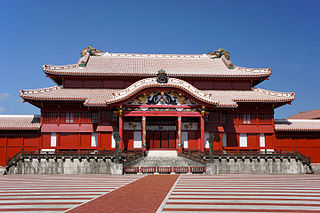
This article is about the history of the Ryukyu Islands southwest of the main islands of Japan.
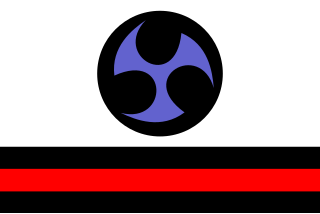
The Ryukyu Kingdom was a kingdom in the Ryukyu Islands from 1429 to 1879. It was ruled as a tributary state of imperial China by the Ryukyuan monarchy, who unified Okinawa Island to end the Sanzan period, and extended the kingdom to the Amami Islands and Sakishima Islands. The Ryukyu Kingdom played a central role in the maritime trade networks of medieval East Asia and Southeast Asia despite its small size. The Ryukyu Kingdom became a vassal state of the Satsuma Domain of Japan after the invasion of Ryukyu in 1609 but retained de jure independence until it was transformed into the Ryukyu Domain by the Empire of Japan in 1872. The Ryukyu Kingdom was formally annexed and dissolved by Japan in 1879 to form Okinawa Prefecture, and the Ryukyuan monarchy was integrated into the new Japanese nobility.
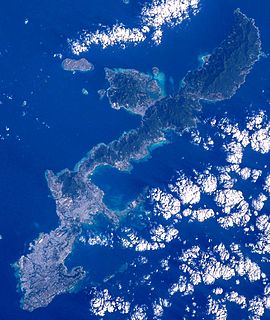
Okinawa Island is the largest of the Okinawa Islands and the Ryukyu (Nansei) Islands of Japan in the Kyushu region. It is the smallest and least populated of the five main islands of Japan. The island is approximately 106 kilometres (66 mi) long, an average 11 kilometres (7 mi) wide, and has an area of 1,206.98 square kilometers (466.02 sq mi). It is roughly 640 kilometres (400 mi) south of the main island of Kyushu and the rest of Japan. It is 500 km (300 mi) north of Taiwan. The total population of Okinawa Island is 1,384,762. The Greater Naha area has roughly 800,000 residents, while the city itself has about 320,000 people. Naha is the seat of Okinawa Prefecture on the southwestern part of Okinawa Island. Okinawa has a humid subtropical climate.

The Amami Islands is an archipelago in the Satsunan Islands, which is part of the Ryukyu Islands, and is southwest of Kyushu. Administratively, the group belongs to Kagoshima Prefecture, Japan. The Geospatial Information Authority of Japan and the Japan Coast Guard agreed on February 15, 2010, to use the name of Amami-guntō (奄美群島) for the Amami Islands. Prior to that, Amami-shotō (奄美諸島) was also used. The name of Amami is probably cognate with Amamikyu (阿摩美久), the goddess of creation in the Ryukyuan creation myth.
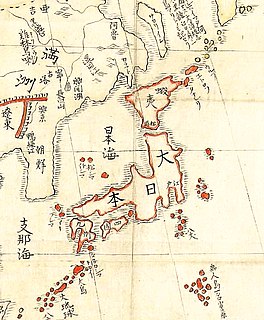
Eiso (永祚) was a Japanese era name after Eien and before Shōryaku. This period spanned the years from August 988 through November 990. The reigning emperor was Ichijō-tennō (一条天皇).

Urasoe Castle is a Ryukyuan gusuku which served as the capital of the medieval Okinawan principality of Chūzan prior to the unification of the island into the Ryukyu Kingdom, and the moving of the capital to Shuri. In the 14th century, Urasoe was the largest castle on the island, but today only ruins remain.

Tamagusuku was a legendary local ruler of Okinawa Island.
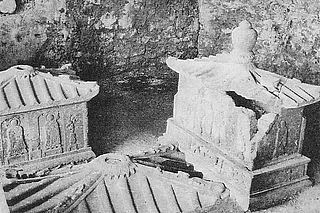
Eiso was a semi-legendary ruler of Okinawa Island. He was the founding monarch of the Eiso dynasty.
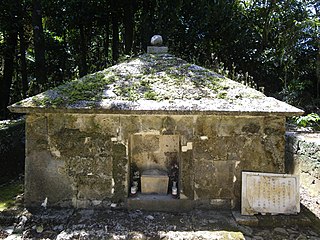
Gihon was a legendary local ruler of Okinawa Island.
Shunbajunki was a legendary local ruler of Okinawa Island. Shunbajunki was the second ruler of the Shunten dynasty. He succeeded his father Shunten in 1237.

King of Ryūkyū, also known as King of Lew Chew, King of Chūzan, or more officially Ryūkyū Kingdom's King of Chūzan, was a title held by several lineages from Okinawa Island until 1879. It effectively started in 1372 when Satto greeted a Chinese envoy from the newly established Ming Dynasty although his son Bunei was the first to be officially recognized as the King of Chūzan. However, the official Okinawan narrative traces the line of succession further back to the legendary ruler Shunten, who supposedly ascended to the throne in 1187. Another peculiar feature of the official Okinawan narrative is the notion of the single line of succession, instead of Chinese-style dynastic changes, even though they clearly recognized that several unrelated lineages had taken over the position.
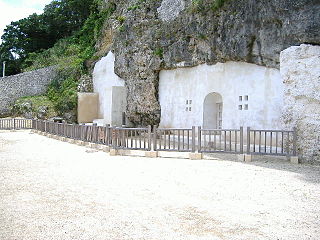
Urasoe yōdore is one of the three royal mausoleums of the Ryukyu Kingdom, along with Tamaudun at Shuri Castle and Izena Tamaudun near Izena Castle in Izena, Okinawa. It is located in Urasoe, Okinawa, in a cave on a cliff to the northeast of Urasoe Castle. It houses the remains of three rulers of the Ryukyu Islands, along with one king of the Ryūkyū Kingdom separated from the others by several centuries.
Ishigaki may refer to:

Shunten, also known as Shunten-Ō, was a legendary ruler of Okinawa Island. Shunten is the earliest chief in Okinawa for whom a name is known. He is said to have taken power after defeating a usurper to the throne by the name of Riyū who had overthrown the 25th chief of the Tenson dynasty.
Eiji was a legendary local ruler of Okinawa Island. Born as the second son of King Taisei, his mother’s name was unknown.
Taisei was a legendary local ruler of Okinawa Island.
The Tenson dynasty (天孫氏王統) was the first dynasty in the traditional historiography of the Ryukyu Islands. According to the Ryukyuan creation myth, the Heavenly Emperor (天帝), who lived in the Heavenly Gusuku (天城), ordered Amamikyu to create the Ryukyu Islands. Without sexual intercourse, she became pregnant by a male deity, Shinerikyu, and populated the islands. Generations of mankind lived in caves and fields. At last there emerged a "heavenly child", who had three sons and two daughters: the first son became the first king, the second son became the first lord (Aji), the third son became the commoners; both daughters became the priestesses, the elder daughter became the first kikoe-ōgimi, while the younger became the first noro. The Chūzan Seikan claimed that the Tenson dynasty had twenty-five kings and ruled for seventeen thousand years. The last king was assassinated and usurped by a powerful official named Riyū (利勇), and later, Riyū was overthrown by Shunten, the lord of Urasoe, who established the Shunten dynasty in 1187.
The Shunten dynasty (舜天王統) was the second dynasty in the traditional historiography of Okinawa Island. It was established by Shunten in 1187. According to Chūzan Seikan, Shunten's mother was a daughter of the aji, or local chieftain, of Ōzato; his father, Minamoto no Tametomo, was an adventurer from Japan. Prior to becoming king, Shunten was the lord of Urasoe. At that time, Okinawa Island was in great confusion; the last overlord of Tenson dynasty was assassinated by the powerful official named Riyū (利勇), whom promoted himself as paramount chief. Shunten revolted against Riyū and overthrew him. In 1187, Shunten was recognized as the new "king". overlord among aji. Though commonly called the "kings", the Okinawan rulers at that time should be more accurately identified as paramount chiefs, or overlords among aji during the Gusuku period.
The Eiso dynasty (英祖王統) was the third dynasty in the traditional historiography of Okinawa Island. It was established by Eiso in 1259. Chūzan Seikan, the first official history of the Ryūkyū Kingdom, claimed that Eiso was a descendant of the ancient Tenson dynasty. During Gihon's reign, Okinawa sufferred from several terrible disasters, including storm, flood and famine. Around 1254, Gihon appointed Eiso to be regent (sessei). Seven years later, Gihon abdicated in favor of Eiso, whom established the Eiso dynasty in the same year. Gihon had to hand over his power because he was unable to manage these disasters and that discontent made it necessary to share authority with a representative chosen from the old Tenson chieftains; or a rival from Tenson chieftains forced Gihon to relinquish power. Though commonly called the "kings", the Okinawan rulers at that time should be more accurately identified as paramount chiefs, or overlords among aji during the Gusuku period.